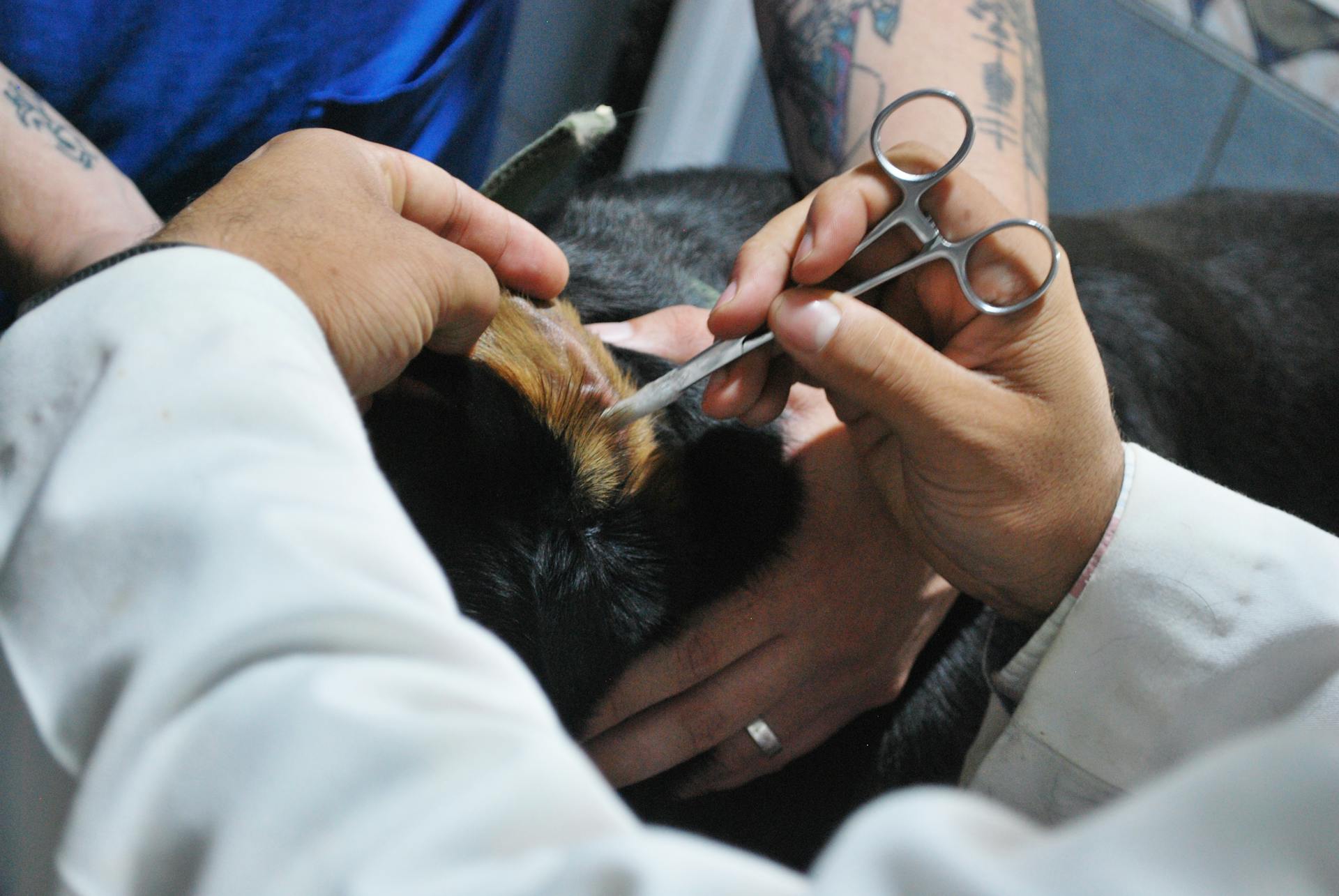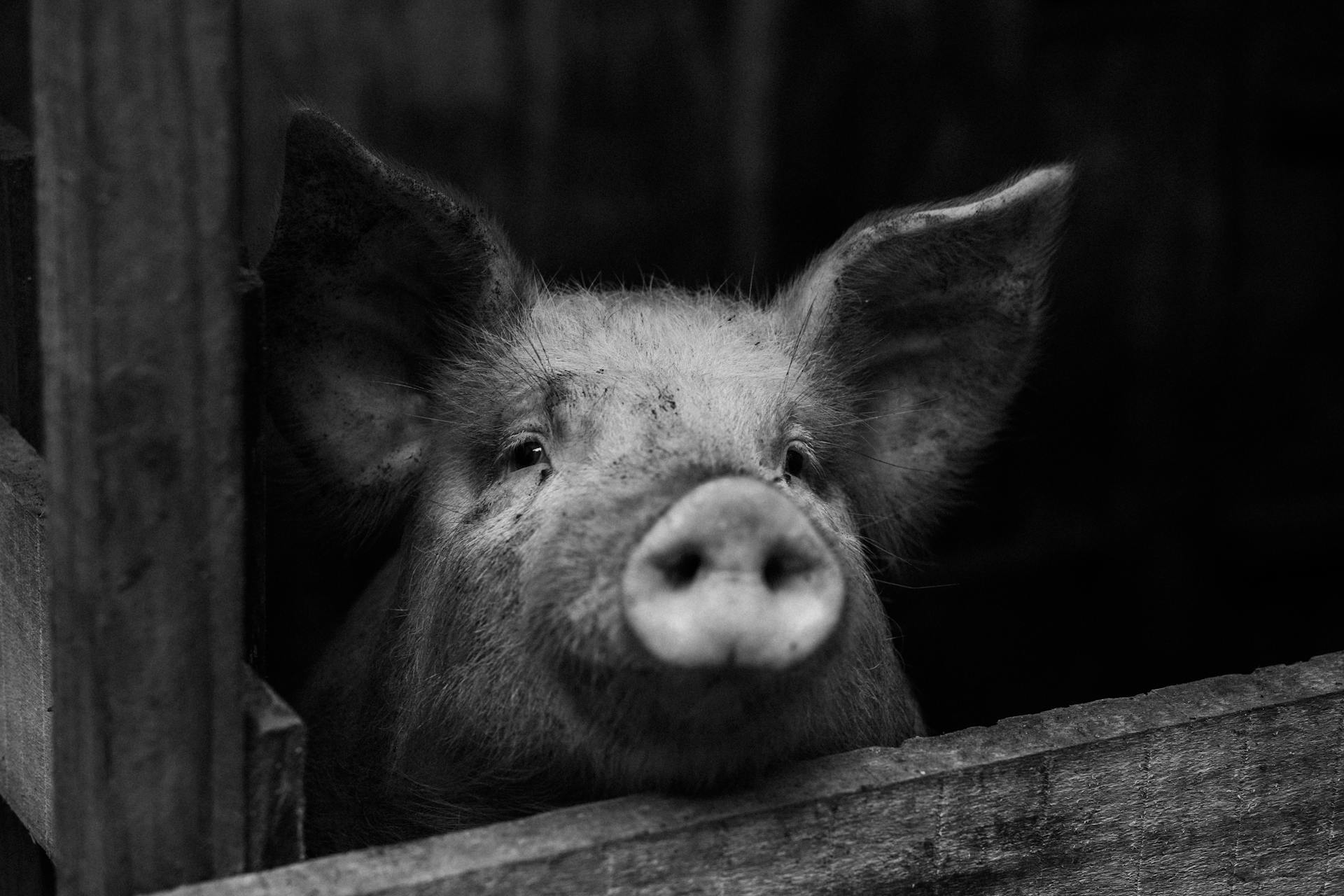
Ear cropping in Dobermans is a procedure that involves surgically removing a portion of the ear to prevent it from flapping or to make it more aesthetically pleasing.
The American Veterinary Medical Association (AVMA) does not recommend ear cropping for aesthetic purposes.
The procedure is usually performed on puppies between 2 and 5 months old, as it is easier to perform on younger dogs.
The surgery can be done under general anesthesia, and the dog will typically need to stay in the hospital for a few hours after the procedure.
The cost of ear cropping can range from $50 to $200 per ear, depending on the location and the veterinarian's fees.
Some breeders and owners believe that ear cropping is necessary to prevent ear infections and injuries, but studies have shown that this is not the case.
In fact, the AVMA states that ear cropping does not reduce the risk of ear infections or injuries.
The decision to crop a Doberman's ears is ultimately up to the owner, but it's essential to consider the potential risks and complications of the surgery.
If this caught your attention, see: What Does It Mean When a Dog's Ears Are Cold?
Pros and Cons
The decision to crop a Doberman's ears and tail is a personal one, and it's essential to weigh the pros and cons before making a decision.
Some argue that ear cropping can prevent ear infections, which can be a common issue in Dobermans.
On the other hand, there are potential drawbacks to ear cropping, such as the risk of complications during the procedure.
Those in favor of ear cropping believe it can improve the dog's overall appearance and make them look more "traditional" in appearance.
However, others argue that ear cropping can be painful for the dog and may lead to long-term health issues.
Proponents of ear cropping also claim it can reduce the likelihood of ear injuries, which can happen if the ears are too long.
But opponents of ear cropping counter that the risks associated with the procedure often outweigh any potential benefits.
Doberman Breed Standard
The Doberman breed standard is set by kennel clubs, and it's a topic of interest for many Doberman owners. The American Kennel Club (AKC) in the United States requires Dobermans to have ears that are cropped and held in an erect position.
In the breed standard, the AKC outlines that the upper attachment of the ear, when held erect, is on a level with the top of the skull. This is the ideal look for a Doberman Pinscher.
Interestingly, the breed standard does not list having natural ears as a disqualifier, but it would be considered a fault due to the line that states any deviation from the described dog must be penalized. This means that a Doberman in the show ring would get penalized for not having cropped ears, but it's not an automatic disqualifier.
The Federation Cynologique Internationale (FCI) has a different breed standard, which does not require the Doberman's ears to be cropped. According to the FCI standard, the ears are left natural and of an appropriate size, set on either side at the highest point of the skull, and ideally lying close to the cheeks.
Worth a look: Dogs Ears Cropped
Risks and Discomfort
Every surgery, including ear cropping, carries inherent risks to your dog. Although rare, potential complications can happen during the procedure, such as infections or even death.
Discomfort and Pain are Possible
Any medical procedure will involve some level of pain or discomfort on a dog. After surgery, your dog may shake their head or try to scratch at their ears due to pain or discomfort.
Pain is Most Noticeable During Stitches Removal
The most noticeable pain from surgery is usually when the stitches are removed or the first bandage change occurs after surgery. Depending on the technique used by the veterinarian, this can sometimes result in crying and/or whimpering during these stages.
Discomfort or Pain
Any medical procedure will almost certainly involve some level of pain or discomfort on a dog.
During the surgery itself, it's unlikely the dog will experience any pain due to the use of general anesthesia.
But there is certainly some level of pain and discomfort afterward.
In my experience with my Dobermans, I have never noticed pain around the time of the surgery.
As the pain medications wear off, at times my dogs would shake their heads, and try to scratch at their ears.
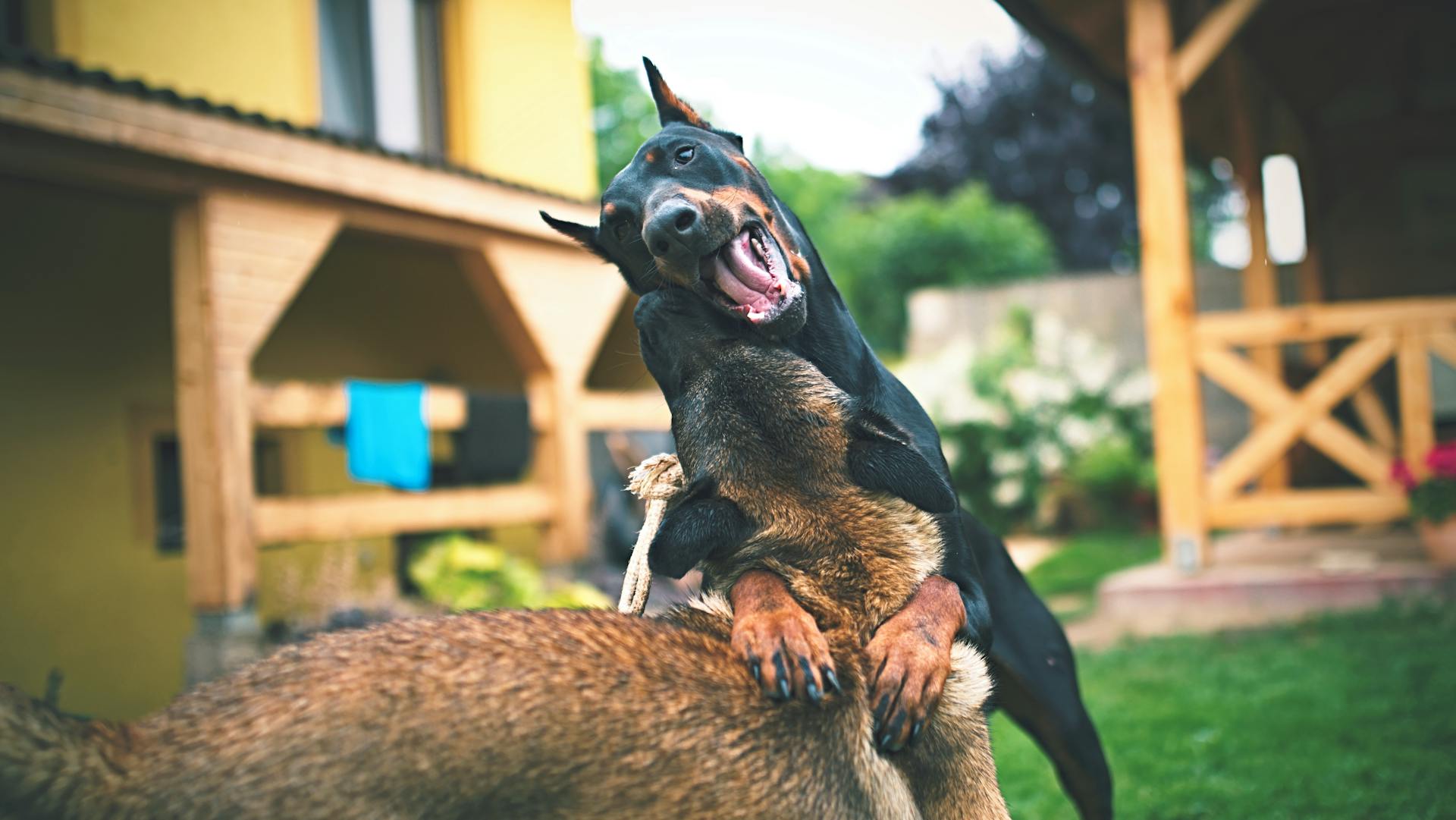
It's unknown how much of this is because of the bandages they're wearing annoying them and how much is due to discomfort.
Where I've noticed the most pain from my Doberman pups is when the stitches are removed or the first bandage change occurs after surgery.
Depending on the technique used by the veterinarian, there is at times crying and/or whimpering during these stages, although not always.
After that, your dog's ears will need to be posted in position usually until their ear cartilage firms up (usually at 6 to 8 months of age).
The bandages and ear posts can be annoying and uncomfortable for the dog.
Posting is Difficult
Ear posting is a challenging task that requires regular maintenance to ensure the ears stay in the correct position.
The process involves removing bandages, posts, and cleaning the ears every 3 to 5 days to prevent dirt and moisture buildup.
This schedule can be adjusted based on the dog's cleanliness, but it's essential to maintain some level of frequency to prevent complications.
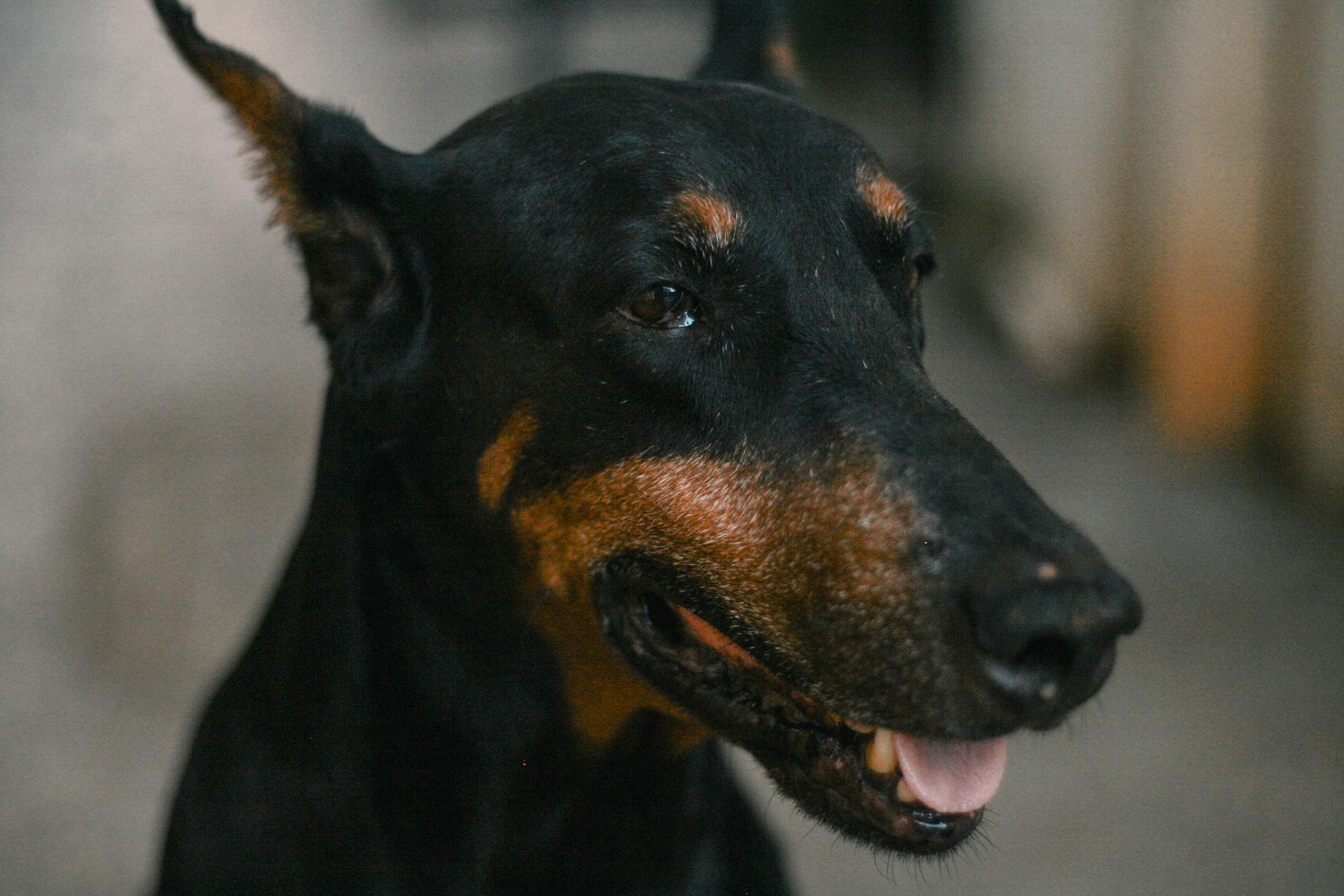
In some cases, owners may need to wrap and clean the ears every day if they get wet or dirty, which can be time-consuming and tiring.
The ear posting process typically continues until the dog is at least 6 months old, but in some cases, it may be necessary until the dog is 1 year old.
Social and Legal Implications
In the United States, it's legal to crop a Doberman's ears as long as a veterinarian performs the procedure. This is a common practice at Doberman club gatherings and kennel club events.
Doberman owners living in other countries need to be aware of varying laws on ear cropping. In some countries, it's completely outlawed, while in others, it's only permitted if medically necessary.
It's essential to do your own research on the legalities of ear cropping in your country, even if a map suggests it may be legal.
Judgement from Others
You may face judgment from others who disagree with ear cropping, especially outside the United States. Many people believe cropping a dog's ears is cruel and inhumane.
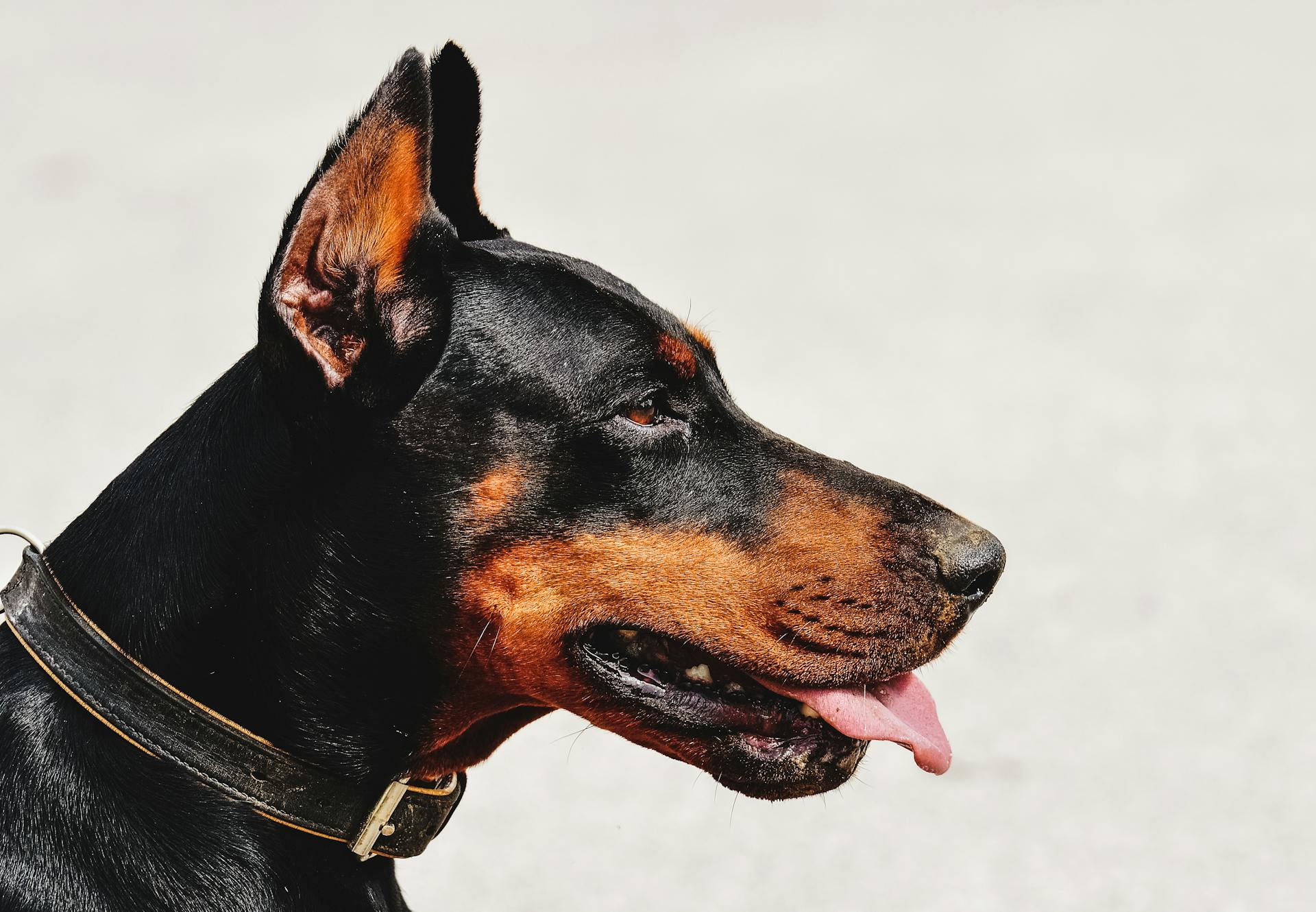
Some may comment that you've "mutilated" your dog or that you don't care about them because of the decision to crop their ears. This criticism can be especially prevalent on social media.
It's easier for people in other countries to see your dog on social media and then pass judgment.
Legalities
Legalities can be a real challenge when it comes to ear cropping in Dobermans. In the United States, it's legal as long as a veterinarian performs the procedure.
The laws on ear cropping vary greatly depending on where you live. In some countries, it's completely outlawed or only permitted if it's medically necessary.
Cropped ears are the norm at Doberman club gatherings or kennel club events within the United States. However, it's essential to do your own research on the specific laws in your area, as the map provided may not be complete or up-to-date.
Although the map shows cropping as legal in Canada, it's actually illegal in many provinces. This highlights the importance of verifying the laws in your region, even if the map indicates it may be legal.
Procedure and After Care
Performing aftercare for a Doberman's ear cropping is a crucial part of the healing process. The veterinarian will provide direction on aftercare, which should be closely followed.
Every 3 to 5 days, you'll need to remove ear postings, clean the ears, and check for any signs of redness, irritation, or infection. You may need to do this more often if your Doberman gets their ears wet or particularly dirty.
Replacing ear posts can take anywhere from 15 to 45 minutes, depending on the technique used and your experience with the posting procedure.
Procedure
The procedure of ear cropping for your Doberman is a serious process that requires careful consideration.
There's a chance the procedure won't be successful, with the ears possibly standing, being crooked, or not standing at all.
Going to a reputable veterinarian experienced in Doberman ear cropping can increase your chances of a successful procedure.
Posting the ears for the right amount of time after surgery is crucial, as stopping too early can impact the outcome.
Getting your dog cropped at an ideal age, between 7 and 9 weeks, can also improve the chances of a successful procedure.
After Care
After Care is a crucial part of the ear cropping process for Doberman Pinschers. The veterinarian will provide you with specific instructions, but here's a general idea of what to expect.
You'll need to post your Doberman's ears until they're around 6 to 8 months old. This can take anywhere from 15 to 45 minutes, depending on the technique and your experience.
Every 3 to 5 days, you'll need to remove the ear postings, clean the ears, and check for any signs of redness, irritation, or infection. This is a crucial step to ensure the healing process goes smoothly.
You may need to do this more often if your Doberman gets their ears wet or particularly dirty. It's essential to be vigilant and adjust the frequency as needed.
Here's a simple schedule to follow:
- Remove ear postings.
- Clean the ears and check for any signs of redness, irritation, or infection.
- Replace ear postings.
This process will continue until your Doberman's ears can reliably stay standing on their own, which usually occurs around 6 months of age. However, it can take up to 12 months in some cases.
Myths and Misconceptions
Historically, there have been many myths and misconceptions surrounding ear and tail cropping in Doberman breeds.
The procedure of tail docking was introduced because some people believed it made Dobermans appear more menacing, despite the fact that this is not a necessary characteristic for a guard dog.
Tail docking is performed on puppies as young as 3 to 5 days old, without anesthesia or pain relief, and has been shown to elicit pain responses such as whimpering and trouble settling.
The idea that the nerves in the tail haven't developed well enough for the amputation to be painful has not been proven, and is not a valid justification for the procedure.
Ear cropping, on the other hand, is performed when the puppies are still with a breeder, and new owners are often unaware of how painful and swollen their freshly amputated ears can be while they heal.
In reality, the ear cropping procedure is painful, and some unscrupulous breeders avoid the costs associated with it by performing the procedure themselves, without anesthesia or pain relief.
You might like: Tail Docking Ear Cropping
The claim that ear and tail cropping must be performed to comply with the breed standard is also a myth, as most of the purported health reasons for cropping and docking have been put forward purely to justify adhering to these standards.
In fact, when tail docking was banned in the UK and Australia, the breed standard of the affected breeds was updated, and the world did not end.
Alternative Perspectives
Dogs are perfect in their natural state, and it's hard to understand why humans would alter their appearances. All dogs, including Dobermans, are beautiful just the way they are.
The practice of ear and tail cropping is rooted in tradition and vanity, but it's essential to consider the dogs' welfare. Humans who care for dogs should prioritize their well-being over aesthetics.
Comparing pictures of Dobermans with cropped ears and tails to those without, it's clear that the natural state is more appealing. The alteration of their appearance can be seen as mutilation.
Some people might argue that ear and tail cropping is necessary for a Doberman's health or safety, but the evidence suggests otherwise.
A different take: Ear Cropping Styles for Dobermans
General Information
Doberman ear and tail cropping is a practice that has been around for centuries. It's a topic of debate among breeders and pet owners.
The Doberman Pinscher breed originated in Germany in the late 19th century, and ear cropping was a common practice among breeders at the time. This is evident in the breed's early history.
Doberman ear cropping is typically performed on puppies between 2 and 5 months old.
Recognizing a Doberman
Dobermans with cropped ears are more quickly recognized as a Doberman, especially in the United States where ear cropping is common.
Their distinctive appearance can make it less likely for someone to challenge the dog due to their reputation for fearlessness and loyalty.
In the US, ear cropping is a common practice among Doberman owners, which can help identify the breed.
A Doberman's reputation for being protective and loyal to their owners can be a deterrent to potential challengers.
Being able to quickly identify a Doberman as such can also prevent misidentification as a hound dog or mutt.
Dogs
Dogs are perfect just the way they are, and it's puzzling why humans would alter their appearances for tradition and vanity.
All dogs are beautiful, regardless of their breed or size, and they deserve to be treated with kindness and respect.
Dogs in their natural state are often more adorable and charming than those who have been mutilated by humans, such as those with cropped ears or docked tails.
Some people still continue to mutilate dogs for no good reason, and it's essential to educate ourselves and others about the importance of treating dogs with compassion and respect.
Frequently Asked Questions
Is docking tails cruel?
Yes, tail docking is considered a cruel practice that causes significant pain and distress to puppies, as well as depriving them of a natural form of canine expression. Learn more about the risks and alternatives to this outdated practice.
Sources
- https://www.dobermanplanet.com/ear-cropping-pros-and-cons/
- https://www.dogster.com/lifestyle/dog-tail-docking-and-ear-cropping
- https://moderndogmagazine.com/articles/the-truth-behind-tail-docking-and-ear-cropping/
- http://speakingforspot.com/blog/2016/02/08/tail-docking-and-ear-cropping-in-dogs/
- https://dpca.org/breeded/tale-of-tails-a-ears/
Featured Images: pexels.com
